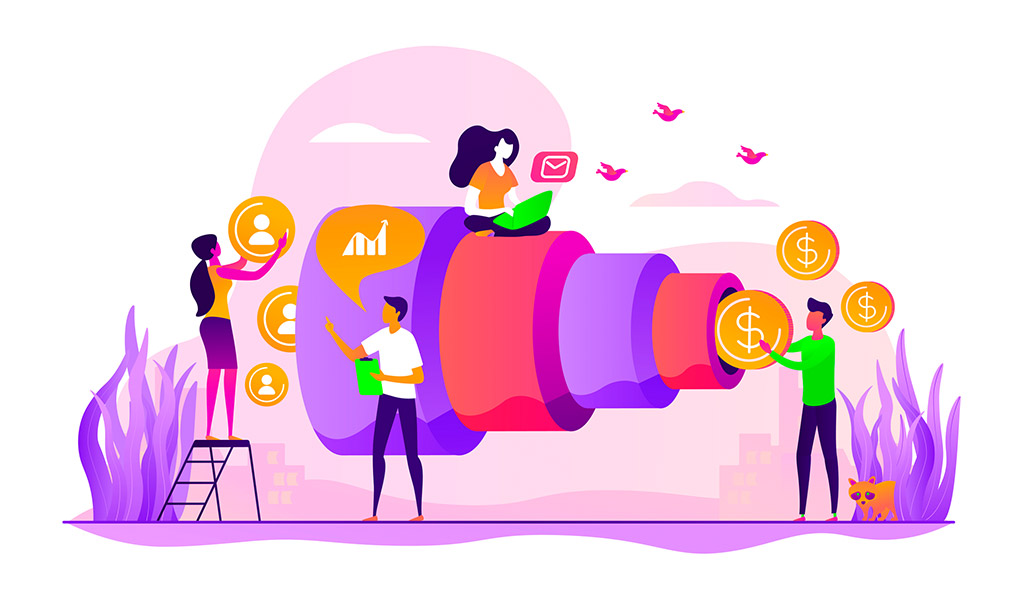Customer Service KPIs. Your sales pipeline is something you need to plan carefully and get right. The success of your pipeline can determine how successful your business is as a whole, so it’s worth putting some extra effort into. For customer service, almost every company out there who actively deals with customer service is tracking their customer service KPIs. Today we’re going to be looking at how to combine these two elements of business into a unified approach to a better sales pipeline, let’s take a look.
What is a Sales Pipeline?
Before we can get started, we need to know exactly what a sales pipeline is. Put simply, a sales pipeline is a set of stages that a new prospect moves through on their journey to becoming a customer. They start as a prospect, then become a lead, and eventually become a customer if they advance through each stage in the pipeline.
You may also have heard the term sales funnel. Many people confuse a sales funnel and a sales pipeline because they have many components in common, but they do have a distinct difference. A sales pipeline is about the actions the sellers (the business) take. A sales funnel is about the actions the consumer takes on their journey to becoming a customer. The key difference is perspective.
The exact stages in a sales pipeline look different from business to business, but a typical sales pipeline looks like this:
Qualification – Meeting – Proposal – Closing
As you move through the pipeline, the numbers naturally dwindle. For example, you might have 20 Qualifications, but only 12 of these people advance to the Meeting stage. Then only 8 of these people will advance to the Proposal stage, and lastly, only 3 or 4 people might be closed and become a customer. You can’t convert every potential customer into a fully-fledged customer.
Why is the Sales Pipeline Important?
Sales pipelines are important for tracking and analyzing the success of your sales process. You can see how some sales methodology is more successful than others by analyzing how many Qualifications are converted to Closed deals. You can also set realistic expectations for future approaches or products. Data is extremely powerful when it comes to planning for the future. You can plan your future marketing, projects, new products, and other company initiatives with a strong and accurate sales pipeline.
What Are Customer Service KPIs?
There are almost endless things you track in customer service. We are now at a stage with omnichannel platforms and advanced data analysis that you can find patterns in almost any type of data. For this section, we’re going to focus on the key metrics that every business with an actualized customer service function should be capturing.
Without measuring the effectiveness of your customer service function, you cannot ensure the success of the team. Measuring lets you know where you are falling short and where you are excelling. It tells you what areas you need to focus on in the future and how to better connect with your customers. Here are the key things you should track:
- Customer response time – How long on average does it take for a customer to get the first response form their ticket.
- Customer satisfaction – This is usually done with a 1-5 scale of very unsatisfied to very satisfied.
- Net promoter score – Measuring the loyalty of your customers towards your company. You can identify the detractors and promoters of your brand
- Resolution time – How long it takes to resolve a customer request.
- Agent load – The total number of customer requests that an agent has to deal with at any given time. This can help you identify whether your agents are overwhelmed.

How to Use Customer Service KPIs to Build Your Sales Pipeline
The success of the sales team relies on setting up qualified leads and then closing deals to make these leads into a customer. Your customer service KPI data will tell you a lot about your existing customers, and by deeply understanding your existing customers, you can begin to attract new customers.
Who is Your Ideal Target Customer?
People are diverse and varied in these interests and experiences, and these people are your customers. No two customers will be exactly alike, but you will have customers who fit into certain profiles. Put simply, your ideal customer is someone who gets their needs met by buying your product or service.
This definition is fairly broad so it can be broken down further. For example, let’s say you own a car dealership. Your ideal customer is someone who wants to buy a car. However, if you only sell budget cars, then you will meet the needs of everyone who wants to pay a modest amount of money for a car, but not those who want to buy luxury cars. In this situation, your ideal customer would be someone who is young and on a low income, or something who is very economical and thrifty of any age. Selling a car to someone who wants a luxury car will be much more difficult because you need to convince them that your product meets their needs. And if their needs are a status symbol, expensive interiors, and lots of customization, then you’ll be stuck finding ways to make your cars fit into this.
Here is how you can find out who your ideal customer is:
Look at your net promoter score in your customer service KPIs.
What do the promoters of your brand have in common? If you’re not sure, you can send out a voluntary survey to these promoters to find out more about them and build a profile. Similarly, what do your detractors have in common? If you know who doesn’t like your product, you can either look at ways to change your product or not focus on these customers. For example, McDonald’s offers vegetarian options in many countries. This might be a way of reducing the impact of detractors to their brand. A Vegetarian is likely not McDonald’s ideal target customer, but plenty of vegetarians are friends with McDonald’s ideal customers. Friends like to eat in the same place and ideal customers might become frustrated if they can’t eat with their vegetarian friends.
Define Your Goals
Not all qualified leads are equal. Many businesses choose to focus more attention on their ideal customers or those they are more likely to convert. Do you want to focus on these customers or are you looking to expand into a new customer base? Your sales team must have clarity about where they should focus, and they must also have realistic targets.
if your sales team was previously told to focus on people with the ideal customer profile but are now being told to focus on a wider customer base, then don’t expect them to have the same success. There is always a learning period when you change approach and it’s unfair to expect the same results each time.
Utilize Text-Based Analysis
Do you have chatbot logs of conversations with customers? What about live chat or WhatsApp conversations? This data houses key insights into how customers interact with your business. By knowing how customers typically react, you can tailor your approach to meet their expectations or even exceed them.
Text-based data is great for this because it’s incredibly easy to search or find insights into, much more so than voice or call data. You can look for keywords, find which words your customers use the most, and find out what they like about your brand. Do issues with one product come up more than your other products? Do customers have the same issues over and over? Is there something a lot of customers don’t understand about your product. These are all things you can utilize in your sales approach. You can use the customer satisfaction score to determine how many customers like your business or product. You can then ask why they like it and use this information to market to consumers.
For example, if customers are continually asking “does your software do X?” then this probably means you haven’t communicated this feature clearly enough. Maybe it’s getting lost in the sea of other features in your description, but it’s also very important to customers. Your sales team can clearly communicate this feature when talking to potential customers. This might encourage these consumers to move to the next stage in the pipeline if this feature is important to them.

Be Vocal About Your Strengths
Is your customer resolution time great? If so, then use this to your advantage in sales. Customers become anxious when they encounter a problem with a company or have a negative interaction. For many customers, they just can’t have confidence in your product if they can’t be assured, they will be well taken care of if anything goes wrong.
This is at the heart of why customer experience is so hot right now. Sure, cheap products are great, but they are no longer cheap if they stop working and you can’t get in touch with the company in a reasonable time. In this situation, many customers will feel forced to buy a new version of the product from a competitor. They will now be extremely frustrated that they’ve had to buy the same product twice when they could have bought it once and paid a little more for it. Confidence in your brand is hugely important, so make sure you give customers a reason to be confident. If your resolution time is great, then communicate this to leads early on and establish yourself as a customer-focused company.
Take Care of Your Employees
This is where agent load comes in, among other things. Your potential customers will advance more successfully through each stage of the pipeline if they are being handled by happy and capable staff. If your agent load is high, then your agents might be overworked and overstressed which can lead to poor customer service. It can also lead to longer resolution times or longer first response time.
It’s important to remember that the sales staff aren’t working in a closed system. Sometimes converting a potential customer into a customer can take several days, weeks, or months. The sales agent isn’t talking to the customer the whole time, but the customer might choose to interact with the business during this time. There’s little point having a very attentive sales agent if you have a potential customer who chooses to go through customer service with their question and has a negative experience. This will undermine everything the sales agent is saying. You must be consistent across all points of contact with customers and potential customers alike. Any claims the sales team makes must stack up if you want customers to have confidence in your brand.




















